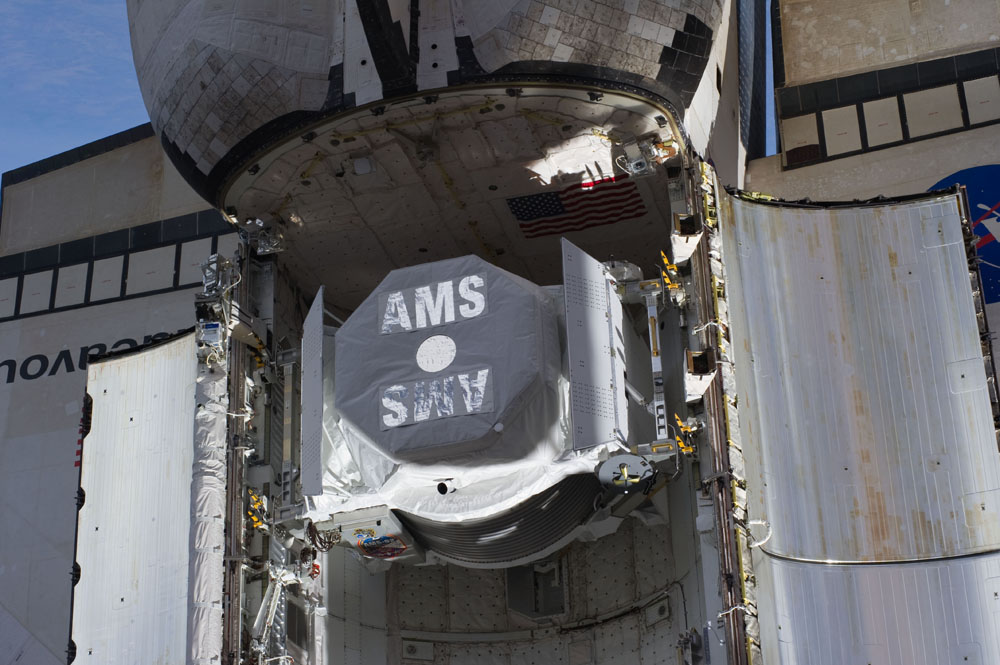Astronauts Ring In Antimatter-Hunting Space Experiment's 1st Birthday

A team of astronauts, including retired spaceman Mark Kelly and his wife, former Congresswoman Gabrielle Giffords, toured a European physics lab today (July 25) to mark the first birthday of the International Space Station's most expensive, ambitious science experiment.
Kelly and the rest of the astronaut crew that helped launch the Alpha Magnetic Spectrometer into space last year paid a visit to the physics lab overseeing the experiment — the CERN laboratory in Geneva, Switzerland.
The Alpha Magnetic Spectrometer, or AMS as it is called, collects cosmic ray particles from space high above the atmosphere of Earth, which blocks most of these rays from reaching the ground. The $2 billion machine aims to probe the nature of the particles that make up the universe, especially the weirdest sides of it, like dark matter and antimatter.
The particle detector was launched on the space shuttle Endeavour's STS-134 mission, the second-to-last flight of the 30-year shuttle program. It was installed on the International Space Station on May 19, 2011 and began operations a short time later.
"The AMS detector has so far achieved everything we expected of it," Nobel laureate and AMS principal investigator Samuel Ting said in a statement. "That's a great credit to the team that put the detector together, and the team that installed it on the ISS. We're honored to have them here today to celebrate AMS's fist year in space."
The lauded experiment almost never made it to space, after the space shuttle Columbia, which was supposed to transport it, was destroyed with its crew in 2003. It took a Congressional vote to add an extra shuttle mission before the fleet was retired in 2011 to revive the AMS project.
Today (July 25), the six astronauts that flew on STS-134 made an appearance at CERN, where AMS' data is analyzed. The crew includes commander Kelly, pilot Gregory H. Johnson and mission specialists Michael Fincke, Greg Chamitoff, Andrew Feustel, all of NASA, and European Space Agency (ESA) astronaut Roberto Vittori. [Video: Space Shuttle Astronauts at CERN]
Get the Space.com Newsletter
Breaking space news, the latest updates on rocket launches, skywatching events and more!
The astronaut crew helped plant a tree to commemorate the launch of AMS, and spoke to more than 200 undergraduate students from around the world studying at CERN for the summer.
"It's a real privilege to visit CERN today, and we're proud to have played a part in launching the AMS experiment's fascinating research program," Kelly said. "Meeting some of the young summer students who represent the future of science and engineering was a highlight."
Kelly was accompanied on the visit by his wife, Congresswoman Gabrielle Giffords of Arizona, the Associated Press reported. Giffords is making her first trip abroad after suffering a gunshot wound to the head in a mass shooting last year. Giffords did not speak publicly, but Kelly told the Associated Press, "She's doing great, she's doing great. She's just here to support me."
During AMS' first year in space, physicists have been using its initial data to calibrate the detector and better understand the extreme space environment in which it functions on the exterior of the space station. The machine has already detected hordes of particles, including some types never seen in nature before.
"Among AMS's achievements is that for the first time, we've been able to identify electrons with energies exceeding 1 TeV before they enter the atmosphere," Ting said. "This holds out great promise for the AMS research program that's now getting underway."
Follow Clara Moskowitz on Twitter @ClaraMoskowitz or SPACE.com @Spacedotcom. We're also on Facebook & Google+.
Join our Space Forums to keep talking space on the latest missions, night sky and more! And if you have a news tip, correction or comment, let us know at: community@space.com.

Clara Moskowitz is a science and space writer who joined the Space.com team in 2008 and served as Assistant Managing Editor from 2011 to 2013. Clara has a bachelor's degree in astronomy and physics from Wesleyan University, and a graduate certificate in science writing from the University of California, Santa Cruz. She covers everything from astronomy to human spaceflight and once aced a NASTAR suborbital spaceflight training program for space missions. Clara is currently Associate Editor of Scientific American. To see her latest project is, follow Clara on Twitter.









